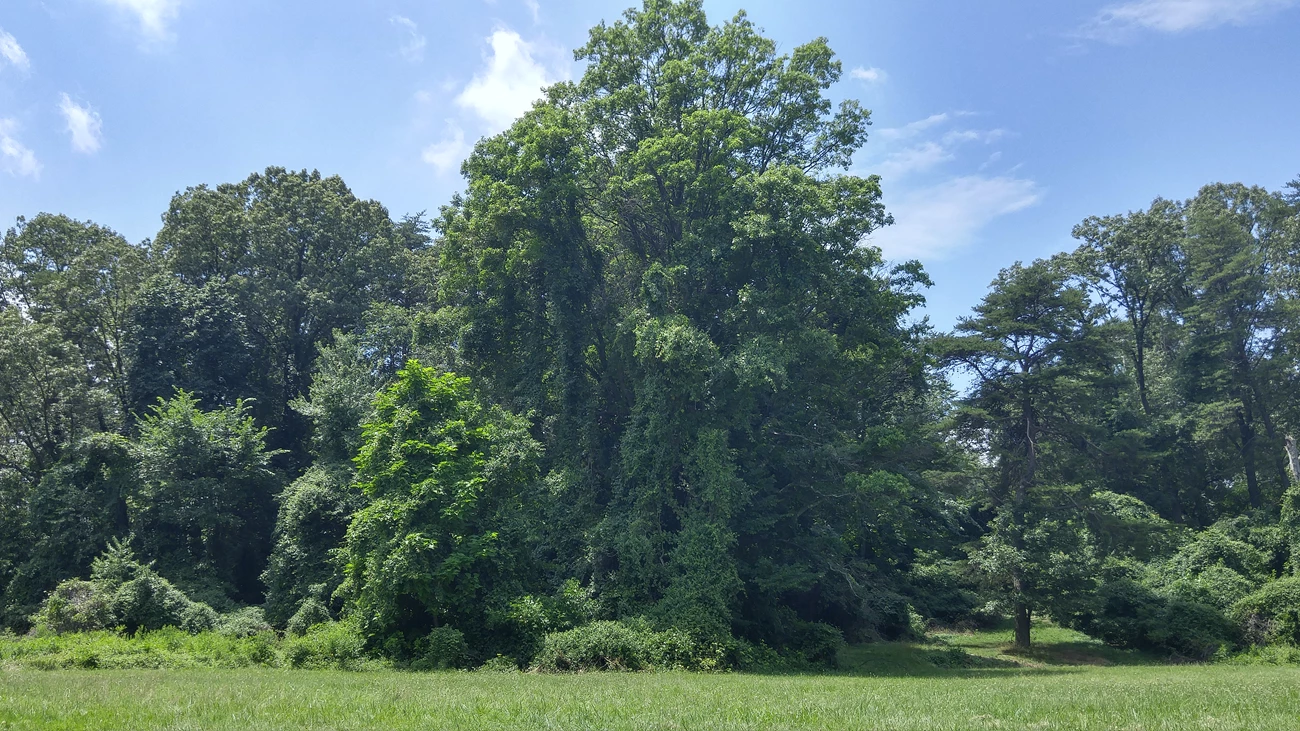Last updated: August 5, 2022
Article
Vines on Trees at Forest Edges

NPS/Nortrup
Climbing vines on trees are abundant and increasing in National Capital Region (NCR) park forests (Matthews 2014). Many tropical forests face similar vine increases due to forest fragmentation and the creation of more forest edge habitat. This is important for both NCR and tropical areas since climbing vines have been shown to change forest structure and composition.
To learn what kinds of changes vines are making in our forests, we looked at data around tree growth rates and mortality, forest edges, and the ecological differences between native and non-native vine species.
Vine Questions & "Treesults"
Are climbing vines on trees becoming more common? Is there a difference between native and non-native vine species?
From 2010 to 2014, the rate of trees with vines rose from 21.5 to 25.7%. Of those vines, the percent of that were non-native invasives increased from 33 to 44%.

NPS
Are climbing vines more likely to spread to new trees if the tree is located near a forest edge?
Climbing vines on trees occur in the highest numbers near forest edges. Figure 1 shows the odds of a vine climbing onto a tree, based on the distance of the tree from the forest edge. Trees within 50 meters of a forest edge are more vulnerable to vine infestation. Non-native vines on trees are constrained to a narrower zone near the forest edge.

NPS
Do climbing vines on trees affect tree growth and mortality?
Most vines climb up trees to get more sunlight, closer to the canopy of trees. Once a vine reaches the crown of a tree, the tree's growth slows. Figure 2 shows that trees without vines in their topmost branches (the crown) generally grew at faster rates than those with vines in the crown, regardless of location.
Trees have different growth patterns based on where they grow, either in the forest interior or near a forest edge. Trees located in the increased light of forest edges grow at faster rates while young, but slow down once they reach a certain size. Trees located in the forest interior grow slowly in their early years and then speed up once they reach larger sizes – growing even faster than the young trees on the forest edge.

NPS
Tree mortality risk is also influenced by vines and proximity to a forest edge. At the forest edge, trees are more vulnerable to a the stressful effects of more wind and sun exposure. So the risk of mortality rises the closer the tree is to a forest edge, and the presence of a vine in the tree’s crown amplifies this risk (Figure 3).

NPS/Coriell
Monitoring
To learn how vines, trees and forest edges interact, we analyzed forest vegetation data collected in National Capital Region parks. We visited 403 forest plots twice between 2007 and 2014. We measured growth rates of trees larger than 10 cm, whether trees were living or dead, any vine species climbing the trunk, and the presence of vines in the tree’s crown.
Further Reading
This material was originally presented in a 2016 resource brief and is based on the article, Climbing vines and forest edges affect tree growth and mortality in temperate forests of the U.S. Mid-Atlantic States. To learn more about how National Park Service scientists are monitoring the health of parks in the National Capital Region, visit the NCRN I&M website.
Tags
- anacostia park
- antietam national battlefield
- baltimore-washington parkway
- catoctin mountain park
- chesapeake & ohio canal national historical park
- fort dupont park
- fort foote park
- fort washington park
- george washington memorial parkway
- glen echo park
- great falls park
- greenbelt park
- harpers ferry national historical park
- kenilworth park & aquatic gardens
- manassas national battlefield park
- monocacy national battlefield
- national capital parks-east
- oxon cove park & oxon hill farm
- piscataway park
- prince william forest park
- rock creek park
- theodore roosevelt island
- wolf trap national park for the performing arts
- vine
- ncrn
- ncrn im
- i&m
- forest
- forest edge
- resource brief
- invasive
- invasive non-native species
- invasive plant
- invasive plant management
- invasive plant species
